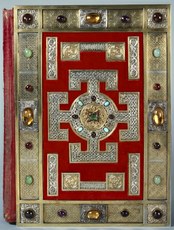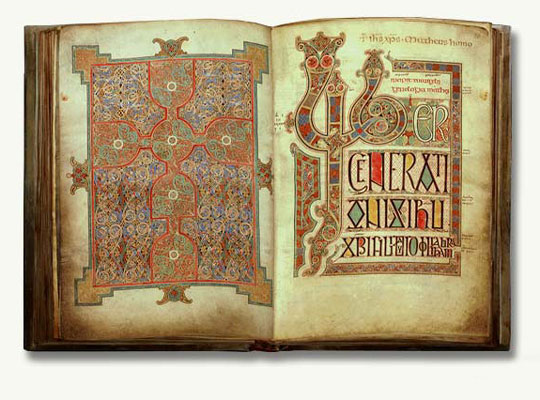The
indigenous Liturgy of the British
Isles developed throughout the first millennium, driven by differing
forces
according to its location. By the middle of the millennium, it was, in
the eastern part of Britain undoubtedly being affected by the incoming
Angles, Saxons etc. The "Celtic-Saxon" Church in the eastern
and
southern British Isles also evidenced changes in architecture and ways
of doing things which carried over even after the papally inspired
invasion
by William of Normandy just after the Great Schism.
The
result of the Synod of Whitby
meant the somewhat patchy introduction of many Roman liturgical and
ecclesiastical
usages into southern England and the Midlands, These generally did not
permeate so well to northern and western England, Cornwall, Scotland,
Wales
or Ireland.
Nevertheless,
in England the Church
was still predominantly local in character and distinct from its Latin
counterparts. The Liturgical customs of the Celtic-Anglo-Saxon Church
were
widely adhered to and in fact, conserved, particularly at Sherborne
Abbey
in the west of England. These liturgical customs were gathered into the
local variant of the Liturgy and eventually became known as the "Sarum
Liturgy" after the Latin name for Salisbury Cathedral where they were
first
expounded. It is important to remember, when looking at the
Sarum
Liturgy that it is essentially a pre-Schism Liturgy which had continued
to develop as the predominant Liturgy beyond the Great
Schism.
In the Western Church in the two centuries immediately prior to the
council
of Trent, Sarum had become influential beyond the bounds of its usage,
and was regarded as the proper standard of ceremonial for anyone not
using
the pure Roman liturgical Use.
It
was expected that the celebrating
Priest and his ministers should sing Prime, the Vesting Chapel Office
and
carry out the preparation of the elements (in Sarum usage, called 'the
Sacrifice' from this point onwards), then sing the Litany in Procession
before beginning the Liturgy of the Altar proper at the end of which,
in
the course of the procession back to the Vestry Chapel, the Priest sang
the Last Gospel, the Eulogion bread was blessed and then, with his
ministers,
he sang the final Divesting Office in the Vestry Chapel. In a
monastic
church, they then returned immediately to sing the Office of Sext.
The
Sarum church has a Rood Screen
which is partly open, allowing the actions at the Altar to be seen
(although
in the great Sarum Cathedrals, the Screen was later usually fully
closed
in). A traditionally laid out church has the Rood Screen crossing the
three
aisles, forming a Vestry Chapel usually on the north side of the Altar
and a Lady (Our Lady - or Preparation) Chapel on the south side of the
Altar, thus creating three doors through the Screen.
The
Sarum Liturgy has the Offertory
Procession bringing the prepared elements solemnly from the Preparation
Chapel to the Altar, the custom known in the East as the Antidoron is
there
in Sarum where it is called the Eulogion, and of course with bowing
instead
of the Roman genuflecting.
The
Sarum Liturgy in its earliest
form, is essentially the fully developed Use of the Church in the
British
Isles prior to the Great Schism and gathered in it the ceremonial
traditions
of the earlier versions of the local Liturgy which had evolved in the
preceding
nine hundred years of its existence. The Celtic (British Isles, western
France and north western Spain) Church seems of a more eastern Empire
origin
than anything, given the differences of organisation, Liturgy,
monasticism
etc., which divided it from Rome. Galatia, Galicia, Gallican, Gaul,
Gallic
and Gaelic, names covering the crescent from modern Turkey through
Poland,
France, Spain, England to Scotland, Wales and Ireland, all mean Celtic.
It
is true to say that the Sunday
of Christianity is much debased today and even for those churchgoers
who
turn up, it seems to be a chore, to be got through in the most informal
dress and as rapidly as possible in order that the rest of the day
might
be enjoyed with other matters.
To
a large extent, for much of the
first millennium, for one of the many genuine, devout Christians of all
classes, the place to be of a Sunday, was the church where, for a brief
period each week, they endeavoured to recreate as best they had means
to,
the worship of Heaven, here in earth.
That
is precisely what the celebration
of the Divine Liturgy is or ought to be. We are doing that
which
Christ Himself directly instructed us to do. Here, in the
Divine
Liturgy, we Orthodox Believers may lose ourselves in Christ.
We may
lose ourselves in the entrance hall of God's Heavenly
Kingdom. Here,
we may, as heirs, look at some hint of our inheritance to
come. Here,
we may have a brief respite from the temptations which distract us from
the character-formation that God requires of fallen man before we can
be
taken into union with Him.
Here
we can savour the things to
come and here, we can meet directly with the Master and be cleansed,
strengthened
and comforted by Him in preparation for the week of trial and
temptation
before us. Here we have joy in God. Without this, he who would be a
genuine
Orthodox Christian has a very difficult task ahead of him indeed.


